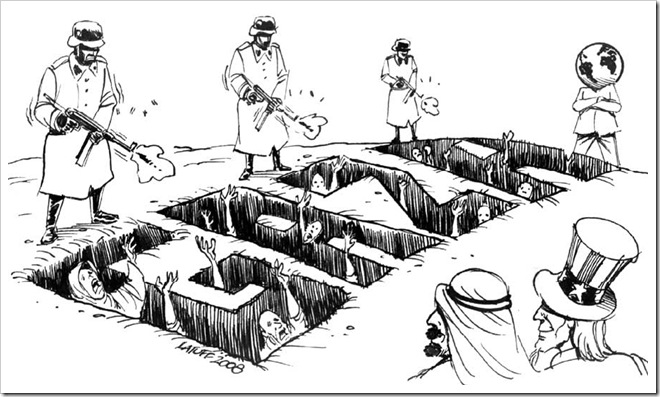European and US weapons in Israeli attack on Gaza Flotilla
 Photo and video material from the Israeli attack on the Gaza Freedom Flotilla expose the use of European and US produced war material. The
Photo and video material from the Israeli attack on the Gaza Freedom Flotilla expose the use of European and US produced war material. The
attack on the relief boats was executed by Israeli navy special forces Unit 13 (Shayetet 13). Several large and small navy ships, as well as helicopters, were used, armed with USand European weapons.
Involved in the attack was a Sa’ar V corvette named Lahav built by US company Northrop-Grumman. The Sa’ar V is fitted with mostly US and Israeli weapon systems, but according to Jane’s Fighting Ships ithas an Italian OTO Melara 76mm canon, which is interchangeable with a Swedish Bofors 57 mm canon. The OTO Melara canon were also used for bombarding the coast of Gaza during the January 2009 war.
Other weapon systems on the Sa’ar V are surface-surface missiles (SSM) from McDonnell Douglas, and Barak surface-air missiles (SAM) from Israeli Industries. It also has US-made Honeywell torpedoes. Command
systems and weapon control are from Elbit and ElOp respectively, both Israeli companies.
No names of the other big ships involved are known but there was at least one Sa’ar 4.5 class involved. Ships of this class are armed– amongst other weapons – with 2 Austrian (? or Swiss M.R.) Oerlikon 20mm guns.
Three helicopters were used in the attack. One is clearly visible on board the corvette. It is not clear from the images which type it is exactly, but the Israeli navy uses two types of helicopters and both are European. It must have been either a Dauphins or a Sea Panther, both by Eurocopter, a subsidiary owned 100% by EADS. They are built by the
helicopter divisions of Aerospatiale-Matra (France) and DaimlerChrysler Aerospace (Germany). On the video one can clearly see that a US Sikorsky UH-60 Blackhawk helicopter was used to drop the Special Forces onto the
ship.
Some smaller attack craft and zodiacs were used as well. Israeli Special Forces have four types. Two types were used against the Freedom Flotilla, Morena Rigid-Hull Inflatable Boats (RHIB) and Zaharon fast boats. The origin of the Zaharon fast boats not known yet. The Morena is produced by U.S.M.I. Louisiana, US, and includes Caterpillar 3126
turbocharged diesel [engines], Furona radar and the MK 19 grenade launcher, all US made, except for the radar which is Japanese.
Israeli propaganda made much of the fact that the Gaza Freedom Flotilla hijackers „only“ used paintball guns (that is until they started shooting people with live ammunition), as if this was somehow a „safe“ or even a nonviolent thing to do. Israeli Special Forces home used paintball guns for close range combat training since the mid 1990′. The two primary paintball guns end-users are the Counter Terror School and the Counter Guerrilla Warfare School. The IDF Counter Terror School also deploys Siminutions (Simulation Ammunitions), which are special paintball rounds fired via the operator’s standard issues weapons, with just the barrel switched temporarily. In this case it might have been
CAR15 (Colt) assault rifles and/or FN High Power handguns (FN, Belgium).
Most of the paintball guns in Israel are M16 clones, which are made either by MF2 or by Gun F/X. However, some of the guns, especially the old ones, are in the common civilian paintball gun shape. The Simunitions impact is quite painful and at very short range it can be lethal.
Research was done by Martin Broek, Ali Abunimah and Carlo Tombola Editing Wendela de Vries
A reliable sources for checking on weapon systems is the website of the Federation of American Scientists. For this research, many other sources were used as well.
—————-
Dexia Israel announces it will continue providing loans and financial services to local municipalities of settlements in the occupied territory
Dexia Israel, a subsidiary of the Belgian-French Dexia Group, provides long-term loans and other financial services to Israeli local authorities in the occupied territory. After Who Profits exposed proofof that fact, and following months of protest and a public campaign led by the Belgian Intal group, Dexia announced, in June 2009 that financing
Israeli settlements is contrary to the bank’s code of ethics, and that the bank would stop providing new loans to West Bank settlements.
However, when approached directly on Dec 30, 2009, the Dexia Israel bank gave the following statement: „Dexia Israel Bank gives services to local municipalities in Israel and there is no decision to discriminate [among
them] by geographic location; additionally, the option of stopping the provision of services to any of them is not being considered“. The bank’s spokesperson made sure we understood that this reference to
„local authorities in Israel“ included Israeli settlements in Jerusalem, the West Bank and the Golan Heights.
By providing these financial services, the bank helps sustain these settlements, which are illegal, according to international law.
Moreover, the bank has failed to supply us with answers about financial services provided to Palestinian local authorities in the West Bank. If the bank provides services to Israeli settlements and not to their
neighboring Palestinian local authorities, it in fact implements the structural discrimination created by the occupation.
http://www.whoprofits.org/Newsletter.php?nlid=54
————————————————————–
From:
War Profiteers’ News, No 24 / June 2010
The email newsletter of WRI’s Global Initiative on War Profiteers
Posted in english, Europa, Friedensforschung, Friedenspädagogik, Friedenspolitik, Gewaltprävention, Internationales Strafrecht, Kriminalität, Krisenregion, Nahost, Rüstungsexport, Unfrieden, USA, Völkerrecht, Waffenhandel, Wirtschaft





